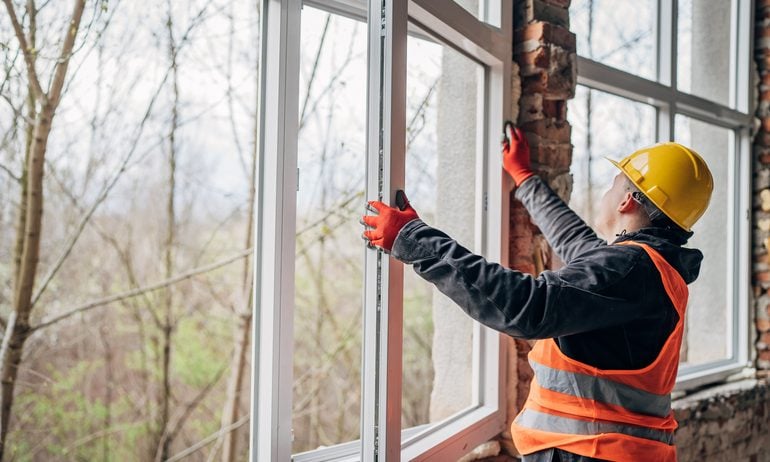Home Window Installation and Repair: What to Expect
Your home window installation or repair process depends on the window company, warranty and type of installation.

Some or all of the mortgage lenders featured on our site are advertising partners of NerdWallet, but this does not influence our evaluations, lender star ratings or the order in which lenders are listed on the page. Our opinions are our own. Here is a list of our partners.
Whether your windows are in need of a quick fix or a complete change, there are several steps to take before hiring a professional to repair or replace them.
Window repair involves checking if you have warranty coverage and hiring a qualified technician. Home window installation has more steps, including choosing a window company, determining the best type of installation for your home and picking the right windows for your climate and home.
How window repair works
Some window damage, like a stuck window, cracked glass or chipped paint, can be fixed with a repair instead of a replacement. Window repairs typically cost from $25 to over $1,000, depending on the damage. Here’s how the window repair process usually works.
If you know what company installed your windows …
1. Checking your warranty
Your existing windows may still be covered under the warranty. Contact your window company or installer to see what repairs are covered, including materials and labor.
Some windows may only need a replacement pane or locking mechanism, for example. In other cases, it may be best to replace the entire window rather than repairing or replacing a single part, especially if it’s an older window.
2. Hiring a repair technician
If your warranty covers repairs and the company that sold your windows has its own repair technicians, you’ll schedule an appointment through them. If just the glass is damaged, you can contact a glass repair company to fix it.
If you don’t know what company installed your windows …
You likely don’t have an active warranty. In this case, you’ll want to determine if you’ll DIY the repair or call a professional. For more complicated repairs, a local window repair technician or handy person can inspect your window and schedule the necessary fixes. It’s possible to DIY a window repair with the right materials, but the process can be dangerous or challenging if you don’t have experience with home improvement projects.
If you choose to hire a professional, make sure you gather at least three quotes so you can confirm you’re getting the best price. You’ll also want to determine if it’s better to fix the window or time to replace the window.
If the window looks newer, you could also try locating the serial number on the window and calling the manufacturer — they might be able to help you track down a warranty if there is one.
on Renewal by Andersen's website
on Champion Replacement Windows Direct's website
How window installation works
If your window frame is rotted or letting in drafts that are hiking your energy bill, it may be time for a replacement. Replacement windows cost from $300 to $2,500 each, including labor, and can cost less per window if you install several at once.
1. Types of window installation
Depending on the structure of your home and the condition of the existing window frames, you may need different levels of installation. Here are a few options:
New construction is when a new building is constructed, or an existing home is getting a new window. It requires new window openings cut into the siding, with new frames and sashes (panes of glass) to go inside.
Full-frame installation or replacement includes taking out the existing frame and sashes and installing new ones. If your old frame is made of wood that’s rotting, for example, or energy-inefficient material, such as aluminum, that’s drawing heat into your home, you may choose to replace the frame. Full-frame replacement can be challenging on brick or stucco homes — it also may cost extra to replace any removed stucco or brick after the window is installed.
Pocket installation or replacement involves inserting a new sash or sashes into the home’s existing frame. This is less labor-intensive than full-frame installation and can be a simpler and more affordable way to upgrade your home’s curb appeal.
Nerdy Perspective
I did a full-frame installation when I replaced the windows on my house a couple of years ago. My house had some termite damage and dry rot around the windows, and I wanted to make sure the new windows were level and had a good base to function properly. Full-frame installation is more expensive, so make sure you get multiple quotes and pick a financing option that fits your budget — don’t just assume the contractor’s financing is the best option.

2. Choosing a window company or installer
Popular window replacement companies offer a wide selection of windows. Many also handle additional home improvement services, such as doors and siding, so that you can complete a larger renovation, including window installation, under one contract.
Choosing a window company with in-house installation can streamline the process and make it easier to pay for the materials and labor all at once. The company may also offer a warranty that includes repairs.
Some window companies work with third-party contractors to install their windows. If you go this route, make sure to check references and make sure the contractor or company is insured.
3. Picking your windows
Window companies offer a variety of frame and glass materials to choose from. You’ll want to make sure you pick the best window for your climate, preference and budget. Many providers can also create custom shapes and styles to fit your home.
Energy-efficient windows or upgrades, such as multiple panes and tinting, can help reduce your energy bill in the future.
How to pay for window installation and repair
Your window company may offer some financing options (either through a partner or a payment plan), but there are other — and maybe better — financing options available.
Which financing option is best for me?
The best financing option for you will depend on how much money you need, when you need the money, what project you’re doing and how long you need to pay the money back. New windows cost $300 to $2,500 each, depending on the kind of window you choose. For a house with 20 windows, that equates to about $6,000 to $50,000.
Since replacing all of the existing windows in your home could add value to your home, a HELOC or home equity loan may be your best option because the value of your house could increase by more than the amount of the loan. Just be aware that most HELOC or home equity lenders often have a minimum initial draw — $15,000 for example — so using your equity may not be the right solution for a lower cost window project. A HELOC makes sense when you plan to do multiple projects over many years, like replace the windows this year and paint in two years.
If it’s a less expensive window replacement like one broken window, a credit card is probably your best option if you want to pay no interest or earn rewards. Personal loans can apply to both small and large window purchases, and they may make sense if you don’t have much equity in your home.
Some window companies offer their own financing options. Before taking this option, shop around and see how their offer compares with other loans.
Regardless of what you choose, make sure you compare interest rates, terms and fees with any financing options you’re considering. This will ensure you get the best deal.
NerdWallet rating 4.5 /5 | NerdWallet rating 4.5 /5 | NerdWallet rating 5.0 /5 |
Est. APR 8.74-35.49% | Est. APR 6.49-24.89% | Est. APR 7.74-35.99% |
Loan term 2 to 7 years | Loan term 2 to 7 years | Loan term 2 to 7 years |
Loan amount $5,000-$100,000 | Loan amount $5,000-$100,000 | Loan amount $1,000-$50,000 |
Min. credit score None | Min. credit score 660 | Min. credit score 600 |













